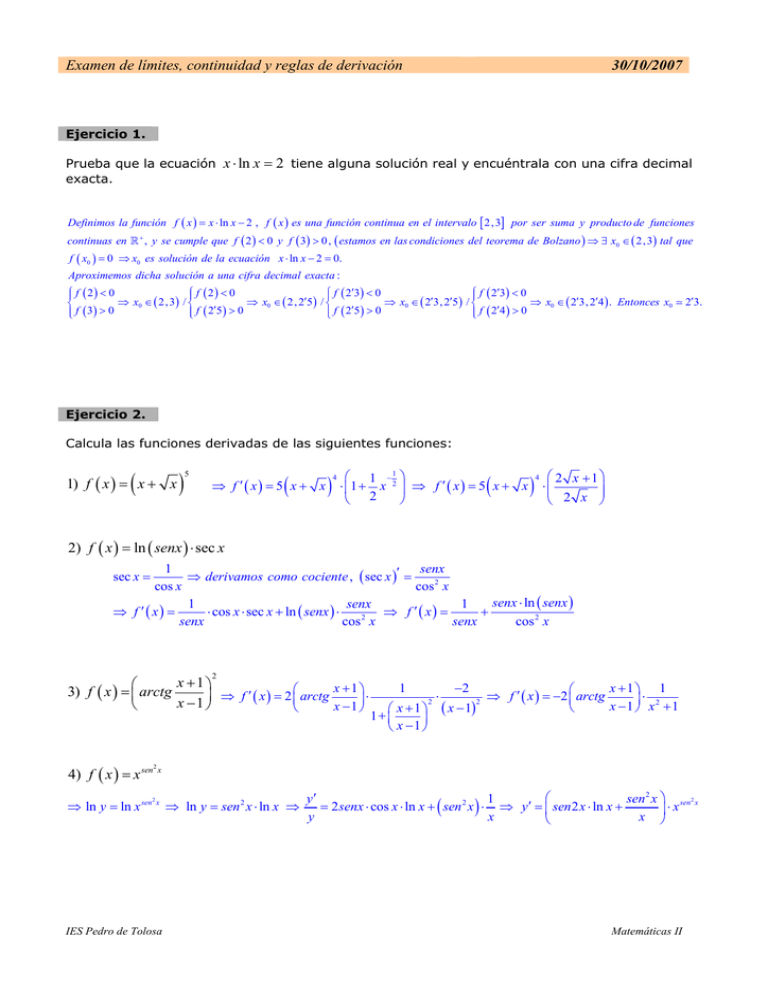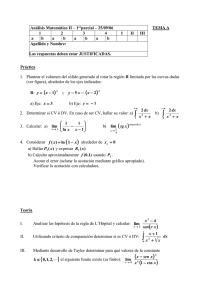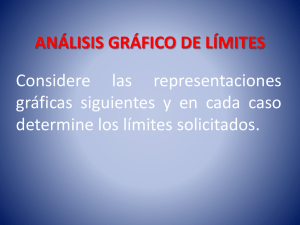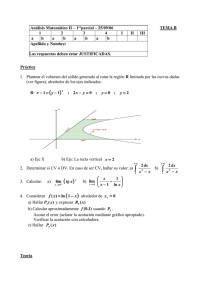Examen de límites, continuidad y reglas de derivación. Curso 2007/08
Anuncio

Examen de límites, continuidad y reglas de derivación
30/10/2007
Ejercicio 1.
Prueba que la ecuación x ⋅ ln x = 2 tiene alguna solución real y encuéntrala con una cifra decimal
exacta.
Definimos la función f ( x ) = x ⋅ ln x − 2 , f ( x ) es una función continua en el intervalo [ 2,3] por ser suma y producto de funciones
continuas en \ + , y se cumple que f ( 2 ) < 0 y f ( 3) > 0, ( estamos en las condiciones del teorema de Bolzano ) ⇒ ∃ x0 ∈ ( 2,3) tal que
f ( x0 ) = 0 ⇒ x0 es solución de la ecuación x ⋅ ln x − 2 = 0.
Aproximemos dicha solución a una cifra decimal exacta :
⎧⎪ f ( 2 ) < 0
⇒ x0 ∈ ( 2,3)
⎨
⎩⎪ f ( 3) > 0
⎧⎪ f ( 2 ) < 0
/⎨
⇒ x0 ∈ ( 2, 2′5 )
⎩⎪ f ( 2′5 ) > 0
⎧⎪ f ( 2′3) < 0
/⎨
⇒ x0 ∈ ( 2′3, 2′5 )
⎩⎪ f ( 2′5 ) > 0
⎧⎪ f ( 2′3) < 0
/⎨
⇒ x0 ∈ ( 2′3, 2′4 ) . Entonces x0 2′3.
⎩⎪ f ( 2′4 ) > 0
Ejercicio 2.
Calcula las funciones derivadas de las siguientes funciones:
(
1) f ( x ) = x + x
)
5
(
⇒ f ′( x) = 5 x + x
)
4
⎛ 1 −1 ⎞
⋅ ⎜1 + x 2 ⎟ ⇒ f ′ ( x ) = 5 x + x
⎝ 2
⎠
(
⎛
⎞
⎝
⎠
) ⋅ ⎜⎜ 2 2 x x+ 1 ⎟⎟
4
2) f ( x ) = ln ( senx ) ⋅ sec x
1
senx
⇒ derivamos como cociente , ( sec x )′ =
cos x
cos 2 x
senx ⋅ ln ( senx )
1
senx
1
⇒ f ′( x) =
⋅ cos x ⋅ sec x + ln ( senx ) ⋅
⇒ f ′( x) =
+
2
senx
cos x
senx
cos 2 x
sec x =
x +1 ⎞
⎛
x +1 ⎞
3) f ( x ) = ⎜ arctg
⎟ ⇒ f ′ ( x ) = 2 ⎛⎜ arctg
⎟⋅
x
−
1
⎝
⎠
x −1 ⎠
⎝
2
1
⎛ x +1 ⎞
1+ ⎜
⎟
⎝ x −1 ⎠
2
⋅
−2
( x − 1)
2
x +1⎞ 1
⎛
⇒ f ′ ( x ) = −2 ⎜ arctg
⎟⋅
x −1 ⎠ x2 + 1
⎝
4) f ( x ) = x sen x
2
⇒ ln y = ln x sen x ⇒ ln y = sen 2 x ⋅ ln x ⇒
2
IES Pedro de Tolosa
⎛
y′
1
sen 2 x ⎞ sen2 x
= 2 senx ⋅ cos x ⋅ ln x + ( sen 2 x ) ⋅ ⇒ y′ = ⎜ sen 2 x ⋅ ln x +
⎟⋅ x
y
x
x ⎠
⎝
Matemáticas II
Examen de límites, continuidad y reglas de derivación
30/10/2007
Ejercicio 3.
Clasifica las discontinuidades de las funciones:
a) f ( x ) =
x2 + x
x2 − x
⎧ x2 − x
⎪⎪ x 2 + x si x < 0
f ( x) = ⎨ 2
posibles discontinuidades en x = −1, x = 0 y x = 1.
⎪ x + x si x ≥ 0
⎩⎪ x 2 − x
Analizamos el tipo de discontinuidad en cada punto.
⎧
⎪⎪ xlim
→−1−
x = −1 ⇒ f ( −1) no existe, lim f ( x ) = ⎨
x →−1
⎪ lim
⎪⎩ x →−1+
⎧
⎪⎪ xlim
→1−
x = 1 ⇒ f (1) no existe, lim f ( x ) = ⎨
x →1
⎪ lim
⎪⎩ x →1+
x2 − x
x − 1 −2
= lim
→ − → +∞
0
x 2 + x x →−1− x + 1
⇒ en x = −1 hay una discontinuidad de tipo infinito.
2
x −x
x − 1 −2
lim
=
→
→
−∞
x 2 + x x →−1+ x + 1
0+
x2 + x
x +1
2
= lim
→
→ −∞
x 2 − x x →1− x − 1 0−
⇒ en x = 1 hay una discontinuidad de tipo infinito.
x2 + x
x +1
2
= lim
→
→ +∞
x 2 − x x →1+ x − 1 0+
⎧
⎪⎪ xlim
→ 0−
x = 0 ⇒ f ( 0 ) no existe, lim f ( x ) = ⎨
x →0
⎪ lim
⎪⎩ x →0+
x2 − x
x − 1 −1
= lim
→
→ −1
x 2 + x x →−1− x + 1
1
⇒ en x = 0 hay una discontinuidad evitable.
x2 + x
x +1
1
= lim
→
→ −1
x 2 − x x →−1+ x − 1 −1
b) g ( x ) = 7 − 2 x − 3
3
⎧
⎧
⎪⎪7 − ( −2 x + 3) si x < 2
⎪⎪2 x + 4
g ( x) = ⎨
⇒ g ( x) = ⎨
⎪7 − ( 2 x − 3) si x ≥ 3
⎪10 − 2 x
⎩⎪
⎩⎪
2
3
Veamos si g ( x ) es continua en x = .
2
3
2
3
si x ≥
2
si x <
, cada rama es continua en el intervalo que está definida.
3
⎛3⎞
g ⎜ ⎟ = 10 − 2 ⋅ = 7
2
⎝2⎠
⎧ lim− ( 2 x + 4 ) → 7
⎪⎪ x → 3
3
2
lim g ( x ) = ⎨
⇒ en x = la función es continua ⇒ g ( x ) no tiene discontinuidades.
3
2
−
→
lim
10
2
7
x
x→
(
)
⎪ 3+
2
⎪⎩ x → 2
IES Pedro de Tolosa
Matemáticas II
Examen de límites, continuidad y reglas de derivación
30/10/2007
Ejercicio 4.
Supongamos que f es continua para todo número real x , excepto para x = 6 . Si
¿para qué valores de x puede asegurarse la continuidad de la función
g( x) =
f D g?
3x
x−2
Para que la función ( f D g )( x ) sea continua en un punto x0 , g debe ser continua en x0 y f continua en el punto g ( x0 ) .
3x
, g es continua en todos los reales salvo en x = 2 ⇒ f D g tampoco es continua en x = 2.
x−2
Como f debe ser continua en el punto g ( x0 ) , g ( x0 ) tiene que ser distinto de 6
Con estas premisas, como g ( x ) =
3x
= 6 ⇒ 3x = 6 x − 12 ⇒ x = 4. Entonces la función f D g no es continua en x = 4.
x−2
Conclusión : ( f D g )( x ) no es continua en x = 2 puesto que en ese punto no es continua la función g ,
( f D g )( x )
( f D g )( 2 ) = f ( g ( 2 ) )
no es continua en x = 4 puesto que ( f D g )( 4 ) = f ( g ( 4 ) ) = f ( 6 ) y f no es continua en x = 6.
f D g es continua en \ − {2, 4}
Ejercicio 5.
Calcula:
1− 5 n
⎛ 2+n⎞
a) lim ⎜
⎟
n →∞ 1 + n
⎝
⎠
b) lim
x →+∞
(
x + x +1
x x − x2 + x + 1
)
a) Indeterminación del tipo 1∞
1−5 n
⎛ 2+n⎞
lim ⎜
⎟
n →∞ 1 + n
⎝
⎠
b) Indeterminación
lim
x →∞
(
1−5 n
⎛ 2+n ⎞
= lim ⎜1 +
− 1⎟
n →∞
⎝ 1+ n ⎠
1 ⎞
⎛
= lim ⎜ 1 +
⎟
n →∞
⎝ 1+ n ⎠
∞
∞ ⋅ (∞ − ∞)
x + x +1
x x − x + x +1
2
1− 5 n
1 ⎞
⎛
= lim ⎜1 +
⎟
n →∞
⎝ 1+ n ⎠
)
= lim
x →∞
x + x +1
x − x +x +x
3
3
2
= lim
x →∞
(
(
x + x +1
)(
x − x +x +x
3
3
2
1−5 n
(1+ n )⋅
1+ n
=e
x3 + x3 + x 2 + x
)(
lim
n→∞
)
x + x +x +x
3
3
2
1−5 n
1+ n
)
=e
1
−5
lim n
1
n→∞
+1
n
= e −5
=
x 2 + x 4 + x3 + x 2 + x 4 + x3 + x 4 + 2 x3 + 2 x 2 + x
x 2 + x 4 + x3 + x 2 + x 4 + x3 + x 4 + 2 x3 + 2 x 2 + x
lim
=
=
x →∞
x →∞
− x2 − x
x3 − ( x3 + x 2 + x )
= lim
( dividimos todo por x ) = lim
2
x →∞
IES Pedro de Tolosa
1+ 1+
1 1
1
2 2 1
+
+ 1+ + 1+ + 2 + 3
x x2
x
x x
x = 1 + 1 + 1 + 1 = −4
1
−1
−1 −
x
Matemáticas II


